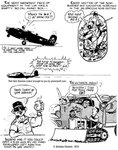Glider
Major
Slower speed = longer in the danger area
Lower altitude = bigger danger to flak
Weak wing
Inability to carry the most effective bombs around (It is mainly a bomber isn't it?)
Surely your not still claiming you can build one in an hour, I thought even you gave up on that one.
Lower altitude = bigger danger to flak
Weak wing
Inability to carry the most effective bombs around (It is mainly a bomber isn't it?)
Surely your not still claiming you can build one in an hour, I thought even you gave up on that one.


